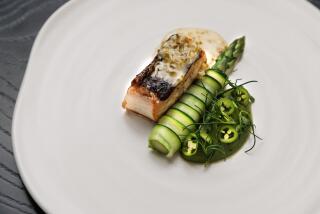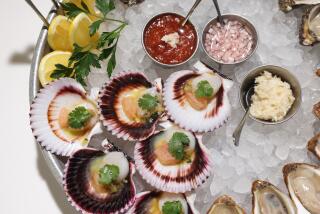THE OTHER SIDE of JAMAICA
- Share via
TREASURE BEACH, Jamaica — I came to Jamaica seeking offbeat seclusion; a calming counterpoint to the bustle of the island’s north coast resorts--Montego Bay, Negril, Ocho Rios--with their haranguing hustlers and ramshackle slums hard up against high-rise hotels. A hustler is someone who makes a living by seizing opportunities. The resorts are full of them, and the biggest opportunity always seemed to be me. Wearingly so, for these artists of psychology practice their trade to devastating effect. (“What matter? You got sometin’ against me? You racist?” . . . )
That is one side of Jamaica. Fortunately, there is another. Beyond the sanitized resorts on the northern part of the island, I knew, was a more prosaic place where I could escape and not be importuned for a week. Treasure Beach and an entirely different Jamaica lay ahead.
Treasure Beach is the generic name given to four bays--Billy’s, Frenchman’s, Calabash and Great Pedro--that lie on Jamaica’s underbelly, on the southern shore. Together they cut a 10-mile swath through St. Elizabeth Parish, 80 miles west of Jamaica’s capital, Kingston. The area is a vast swampy region--Jamaica’s largest extant marshland--that is a rare habitat for crocodiles, waterfowl and a small species of fish called a God-a-me that can live out of water among the moist leaf litter and mud.
I had heard that Treasure Beach is an isle within an isle, isolated by geography and as yet unsullied by tourism. True, the Caribbean Sea is murkier and the sand darker, less tantalizing here than near the north coast resorts, with their beaches of pulverized sugar shelving gently to waters the color of peacock feathers. But I wanted aplace by the sea with plenty of snoozy charm, a peaceful, less developed place where the people are gentle and I could slip into a kind of no-frills lassitude. It is also a place generally spared the crimes against tourists that have plagued some visitors to the north coast resorts, as well as to Kingston, according to the U.S. State Department.
“You’ll not find a more captivating aura and mood . . . nor more lovely people,” Jason Henzell had told me when I called from Montego Bay. Jason and his mother run a Treasure Beach hotel that I had been hearing raves about. The population of Treasure Beach has a reputation for honesty and graciousness unique on the island. “Me tell you. De people are mellow. There are no bandulus,” said Jason, using the patois word for hustlers.
Jason is an island-born descendant of European immigrants, mostly English. He and his mother, Sally, run a funky hotel and restaurant called Jake’s Place atop the coral bluffs of Frenchman’s Bay. He invited me down. “Leave de tourists behind, mon. We’d love to see you!”
I arrived at Treasure Beach via a muddy track, which merged with a narrow, newly paved road that rose above the plains, twisting dramatically along cliff tops, soaring and dipping past agave and tall spiky cactuses. I hadn’t envisaged cactuses in rain-soaked Jamaica. They were my first clue that Treasure Beach is distinct. The area is sheltered from rain-bearing winds by the mountains that rise to the east. There is none of the lush greenery of the north coast or the Black River area. The countryside looked like East Africa: stunted palms and acacias, barren rock landscapes and brown plains chewed on by plump-bellied goats (signs read “We love our kiddies”) and scrawny, humped cattle.
The first hint of life was a sign pointing me to Nuestra Casa Guesthouse, at the west end of Billy Bay, where the road spilled down to the beach. I stopped, and an elderly, sun-lashed woman stepped out to greet me. She was barefooted and wrapped in a batik sarong.
“ ‘Ello luv. Pardon me, but ah’m a bit under t’ weather. Ah’m not takin’ guests right now.”
Her soupy accent was familiar.
“Are you from Yorkshire?” I asked.
“Ay luv. Why? Do yer know it?”
“Ay luv,” I replied, dropping into my childhood vernacular. “I was born there.”
“Were yer? Eeee! Come on in,” she said, inviting me to sit on a veranda festooned with potted plants and knickknacks that could have come from my grandmother’s parlor.
We settled in rockers on a shady veranda and supped Red Stripe beer as Lillian Brooks told me of life at Treasure Beach.
“I don’t know as I could live anywhere else in Jamaica,” she told me. “It’s so peaceful ‘ere. They’re a few scalawags, but only when they’ve ‘ad a bit much rum.”
Many foreigners have settled in Treasure Beach--much to local pride. To think that someone would give up the U.S. or Europe to live in their remote little place! The conviviality, the remoteness and easy pace attracts small handfuls of foreigners whose idea of a good time is watching fishermen return to the beaches, where their womenfolk wait with tubs filled with ice. Each of the bays has its own fishermen’s cooperative. Out-of-towners run the nascent tourism show. Locals cling to the land and sea.
Maureen Collins is manager of the 36-room Treasure Beach Hotel, the largest structure for miles around. It had once been a nudist resort, but local sensibilities were offended and a demure remake was called for. The hotel roosts atop a bluff overlooking Frenchman’s Bay and has one of the few vantage points from which to gain a sense of Treasure Beach’s dissembling geography. The area had recently received a rare dousing of rain, and Maureen and I looked down on a fulgent foreshore as green as ripe limes. Tousled palms cast wispy shadows over a beach lined with modern fiberglass boats and gaily colored pirogues, long, narrow canoes hewn from the trunks of silk-cotton trees. Prim little two-story houses with red roofs eased above the trees.
There isn’t really a village to speak of at Treasure Beach. Nuestra Casa, Jake’s Place, the tidy houses and fisher folk’s cottages are free-standing, sprinkled along the meandering road that links the four bays. At night the lane is unlit. Few locals own cars. Amenities are limited. There are no resorts. Even water sports haven’t yet caught on here. And most of the locals go to bed early, except on weekends, when they migrate like spawning wahoo to the Fisherman’s Bar, a rustic “rum shop,” as the locals call it, to gossip, dance to ska music--the syncopated, horn-driven precursor of reggae--and swig stiff shots of clear overproof rum.
*
Ten steps on the beach and I can leap into a calm sea the color of melted peridot. Eight steps. Four. Two. Whoa! I see a sinister shape in the water. Jason, it appears, has caught a live nurse shark on a fishing foray. Jason is half-seriously pondering putting it in the saltwater swimming pool for guests to swim with. “No mon! De guests not go in de pool!” exclaims Dulcie, the cook.
Jake’s Place is a rustic, rainbow-colored sanctum beside its own pocket-size cove. Sally Henzell has used her creativity as a former film-set designer to evolve a unique Walden-like retreat perfectly fitting the Treasure Beach mood. Her eclectic escape is a pleasing blend of indomitable Jamaican hospitality, Muslim-inspired designs and vibrant Caribbean colors: emerald greens flowing into burning golds, soft pastels and warm ochres relieved periodically by roof posts as blue as the morning sky and bougainvillea as red as bright lipstick. My tin-roofed cottage has only the most meager essentials: concrete blocks for bathroom shelving, a rickety metal-frame hospital bed and a cold-water shower on a veranda, where bullfrogs gather at night to gobble bugs attracted by a low-watt lantern. It is embellished with gingerbread trim, an onion-dome curved doorway, shuttered windows and faux-washed walls inset with colored bottles and glass beads. (There are 12 cottages plus a three-bedroom villa.)
It reminds me of a commune on the California coast. I half-expect a troupe of Hare Krishnas to emerge on the stone pathway that snakes past the amoeba-shaped pool to tiny sun decks suspended in mid-air above the Caribbean. The pool is shaded by a spreading fruit tree, and from it a cascade burbles into a fishpond and thence to the pavonine sea.
*
I’m lying face down beneath the ackee tree’s cool penumbra. Shafts of sunlight play through the leaves, creating a sensation of being showered with rose petals. A breeze releases tropical scents and the only sounds are the rustling of palm fronds and the easy voice of Lee Stein, a 48-year-old masseur from New England who winters at Treasure Beach along with other sorts who like to slumber in hammocks away from the rest of the world.
When I awake I can barely summon the ambition to move on. Still, I’m hungry and so saunter along the dusty, potholed lane, the smell of fresh-baked sugar buns and French bread luring me to the Trans Love Bakery, run by Julie, a transplanted Yankee, and her husband, Ralph, a local man. Half of Treasure Beach, it seems, has been similarly enticed. Jake is there too, wearing a jacket of asparagus green: this rare yellow-billed Jamaican parrot has forsaken Jake’s Place to spend his days cooing tenderly into the ear of Trans Love’s female parrot. I order an omelet ($2.50), muesli ($2.50) and fruit salad and munch contentedly while an old-timer named Martin entertains with folk-calypso songs--called Mento--on slide guitar.
Treasure Beach is a philosophical and metaphysical still-point, preserving, as much as anywhere in Jamaica, a traditional calm that keeps locals rooted and hopeful. Its measured rhythm is like the sway of marine plants in the sweep of an undersea current. Fish are plentiful and the slopes that rise east of Treasure Beach are intensively farmed: melons, peppers and corn grown here supply the rest of Jamaica (because of the arid climate farmers have developed a dry-farming technique of laying guinea grass on the soil for mulch). As a result, the area is relatively prosperous; the people secure and stable.
But word is getting out that this area offers something special, and Treasure Beach is awakening from its Rip Van Winkle slumber.
Jamaica’s south coast is now being marketed by the Jamaica Tourist Board. The area, comprising the flatlands of St. Elizabeth Parish and the wedge-shaped uplands of Manchester Parish to the east, is Jamaica’s new tourism frontier and one replete with attractions, most prominently the Great Morass, Bamboo Avenue and YS Falls (pronounced WHY-ess), a beauty spot to rival the world-famous Dunn’s River Falls near Ocho Rios. The area is establishing itself as a node for the nation’s nascent eco-tourism. And as the spotlight increasingly shines on Treasure Beach, its reclusiveness is poised to change. Developers are buying up land; it is only a matter of a few years before the first large hotels appear.
At first sight that seems like good news. Beyond the Jamaica Tourist Board’s cliches lies a country beset with widespread poverty (the island’s meager per capita gross domestic product is only $1,475). The drift from countryside to city occurring throughout the Third World has been felt no less forcefully in Jamaica. A lucky few starry-eyed youths find work; for most, the illusion ends in slums made of fish barrels and packing cases.
Treasure Beach is different. Although a few residents look forward to the employment benefits tourism development will bring, many see the arrival of large-scale resorts as a threat to their stable community life. They think the region’s future lies in a more sensitive kind of tourism, different from the all-inclusive, charter-package syndrome of the north coast.
The area is thus shaping up as a battleground between developers and community leaders.
But resort developers are politically favored. Plans are moving ahead for three resorts about 30 miles west at Bluefields Bay that have local residents concerned about the disruption of their bucolic ways. Already, farmers are being forced from their land by rising real estate prices and fishermen fear dwindling fish stocks from mangrove destruction. Largest of the proposed projects is an all-inclusive resort to be built, perhaps as soon as this year, by the Sandals chain at Whitehouse, a few miles west of Black River. The resort, Beaches, is slated to occupy a nesting site for marine turtles. The corporation has promised to spend considerable sums to minimize the resort’s environmental impact.
To see turtles, I drove up and over the teardrop-shaped Santa Cruz Mountains to a town called Bull Savannah spiraled down to Alligator Pond, a fishing village hidden within a valley concealed from the rest of the country. Its sole street was smothered in sand. From here, a tortuous road leads east along an uninhabited swampy shoreline towered over by thatch palms.
The swamp is also the last refuge in Jamaica for endangered manatees. They look like plump wine sacks and paddle along gobbling water hyacinth and expelling methane gas, which bubbles up flatulently. The lonesome, seemingly endless red sands of Long Bay are favored by female turtles, which drag themselves puffing and panting across a wide expanse of beach to lay their precious treasure: the seeds for tomorrow’s turtles. Unfortunately, the lustrous shell of the hawksbill, one of three marine turtle species here, is much sought after for jewelry.
Though manatees and marine turtles are protected, Jamaican fishermen display a disturbing frontier disregard for the law, and the only turtle I see is being hauled off to be turned into soup and hairpins.
I decide to retreat to the benign calm of Treasure Beach, where I sit on my veranda drinking rum coconut with pineapple juice as fireflies--peeny-wallies, as the locals say--fly by and geckos call from the eaves.
(BEGIN TEXT OF INFOBOX / INFOGRAPHIC)
GUIDEBOOK
Riches of Treasure Beach
Getting there: American Airlines, Northwest and USAir fly with one change of planes from LAX to Montego Bay. Advance-purchase round-trip fares start at $595.
Air Jamaica will begin once-a-week, nonstop service between LAX and Montego Bay March 23. Advance-purchase, round-trip fares start at $425, if tickets are purchased by Feb. 15 and travel is between March 23 and May 23.
Treasure Beach is 64 miles southeast of Montego Bay and is easily reached on paved roads by rental car. Major U.S. rental companies have offices in Jamaica, as does Island Car Rental (in the U.S., telephone [800] 892-4581 or [809] 952-5771, Jamaica’s largest rental company. Driving is on the left side of the road.
Where to stay: Jake’s Place has 12 eclectic and endearing cliff-top cottages and a three-bedroom villa renting for $50 and $475 respectively. Meals, which cost extra, are enjoyed at the trendy restaurant out front, or on the shady patio beside the pool. Contact Jake’s Place, Calabash Bay, Treasure Beach PA, Jamaica; tel./fax (809) 965-0552 or (800) 688-7678.
Golden Sand Beach Cottages rents single rooms and suites on the beach, with prices ranging from $25 to $75 per night. There is no dining room, but restaurants are within walking distance. Golden Sand Beach Cottages, Frenchman District, Treasure Beach, St. Elizabeth, Jamaica; tel. (809) 965-0167.
Nuestra Casa Guesthouse is Lillian Brooks’ charming three-bedroom house that rents for $30 for a double. Breakfasts cost $5. Nuestra Casa, c/o Calabash Bay PA, St. Elizabeth, Jamaica; tel. (809) 965-0152.
Treasure Beach Hotel is a more traditional hotel above Frenchman’s Bay with 36 air-conditioned rooms, including 16 ocean-front suites with king-size beds. Facilities include a pool and a restaurant. Rooms are priced $100 to $145 for a double. Treasure Beach Hotel, P.O. Box 5, Black River PA, St. Elizabeth, Jamaica; tel. (809) 965-0110, fax (809) 965-0114.
Where to eat: Trans-Love Bakery is favored for breakfast. It serves fresh-baked goods, plus huge omelets ($2.50) and bowls of muesli ($2.50). A special Sunday breakfast costs $7. Call (809) 965-0486.
Jake’s is charming. Stuffed crab backs ($7), lobster Sichuan ($14) and vegetable pasta ($4) are typical. Call (809) 965-0552.
Yabba Restaurant at Treasure Beach Hotel serves traditional Jamaican dishes such as ackee and salt fish or curried goat; about $5 for entrees; tel. (809) 965-0110.
Safety: Crime is a serious problem in Kingston, according to the U.S. State Department, and other cities in Jamaica are similarly plagued with thefts and robberies of tourists.
For more information: Jamaica Tourist Board, 3440 Wilshire Blvd., Suite 805, Los Angeles 90010, tel. (213) 384-1123; fax (213) 384-1780.
More to Read
Sign up for The Wild
We’ll help you find the best places to hike, bike and run, as well as the perfect silent spots for meditation and yoga.
You may occasionally receive promotional content from the Los Angeles Times.






